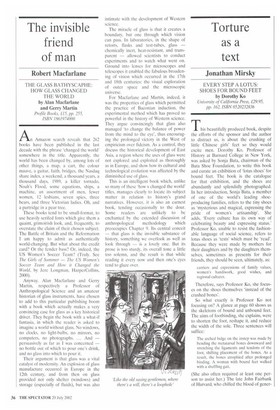Torture as a text
Jonathan Mirsky
EVERY STEP A LOTUS: SHOES FOR BOUND FEET by Dorothy Ko University of California Press, £29.95, pp. 162, ISBN 0520232836 This beautifully produced book, despite the efforts of the sponsor and the author to distract us, is about the crushing of little Chinese girls' feet so they would excite men. Dorothy Ko, Professor of History at Barnard College in New York, was asked by Sonja Bata, chairman of the Bata Shoe Foundation, to write this book and curate an exhibition of 'lotus shoes' for bound feet. The book is the catalogue for that exhibition, and the shoes are abundantly and splendidly photographed. In her introduction, Sonja Bata, a member of one of the world's leading shoeproducing families, refers to the tiny shoes as 'mysterious and magical, expressing the pride of women's artisanship.. She adds, 'Every culture has its own way of celebrating beauty and expressing status.' Professor Ko, unable to resist the fashionable language of social science, refers to lotus shoes as 'texts' which must be 'read'. Because they were made by mothers for their daughters and by the daughters themselves, sometimes as presents for their friends, they should be seen, ultimately, as:
carriers and expressions of family values, women's handiwork, good wishes, and regional cultures.
Therefore, says Professor Ko, she focuses on the shoes themselves 'instead of the crushed bones'.
So what exactly is Professor Ko not focusing on? A glance at page 60 shows us the skeletons of bound and unbound feet. The aims of footbinding, she explains, were to shorten the foot, reshape it, and reduce the width of the sole. Three sentences will suffice:
The arched bulge on the instep was made by bending the metatarsal bones downward and stretching the ligaments and tendons of the foot, shifting placement of the bones. As a result, the bones atrophied after prolonged binding. A woman with bound feet walked with a shuffling gait.
(She also often required at least one person to assist her.) The late John Fairbank of Harvard, who chilled the blood of gener ations of students with x-ray photographs of bound feet, in his China: A New History described more bluntly than Professor Ko how 'your four minor toes on each foot are pushed down and around and under the balls of your feet'. The result was that the flat of the woman's heel and the ball of her feet now faced each other `so that an object like a silver dollar can be inserted in the narrow space between them'.
Fairbank also observed that 'behind footbinding lay a male sexual fetish that has been noted by many but seldom really investigated'. This is plain in Chinese pornography; the upper leg of a woman with bound feet was supposed to be extra strong, and her vagina was said to be powerful. Men were supposed to enjoy a wonderful grip. In the paintings, in whatever position the amorous male devised, he was likely to be holding his partner's foot, invariably in a tiny white sock. The sock prevented the man from seeing, handling, or smelling the woman's deformed foot. Professor Ko describes such pictures as pleasurable, tender, and discreet.
To be fair to Professor Ko she does devote one sentence in her 162 pages to the purpose of this mutilation: 'It is undeniable that footbinding was born of a male fantasy that turned women into objects of their amorous desires.' But in a catalogue sponsored by Bata about 'mystery and magic that sentence is enough. 'In this book we do not have the space to trace the history of the practice in the ars erotica.' No ars erotica then. Instead, many pages on 'footbinding [as] an entirely new set of meanings, as a celebration of women's work and motherhood'. She shows one photograph of a naked bound foot but it is intended to display `the illusion that bound feet were very very small'. In fact, Professor Ko assures us, bound feet were bigger than their shoes. 'Illusion,' she says, lay at the heart of footbinding.' Now comes the most astounding phrase in the book: `in anatomical terms, footbinding did not so much destroy the mass of tissues and bones of the foot as redistribute them'.
Professor Fairbank, who might be dismissed by Professor Ko as a culturebound male, says:
Possibly the practice of clitoridectomy, in certain parts of Africa, performed by women on women (as was footbinding) is in some ways comparable, yet as a social iniquity visited upon hundreds of millions of women. footbinding is in a class by itself, a unique aspect of Chinese culture.
Professor Ko purports to give a history of footbinding, but fails. She shows that from very early times women wrapped pieces of cloth around their feet to make them appear small and quotes from charming poems and songs to this effect. But there is no evidence that crushing the foot began before the 13th or 14th century and Professor Ko doesn't attempt to explain why or how.
She regrets the passing of footbinding, beginning in the late 19th century. 'Footbinding,' she writes:
became a stand-in for everything that was wrong about 'tradition', [and] transformed the meaning of a practice that had thrived on women's private knowledge, labour, rituals, and artistry.
But there were Chinese men, not under the influence of Western missionaries and their wives, who understood the essence of footbinding from which Bata and Professor Ko wish us to look away. Between 1810 and 1820, the satirist Li Ruzhen wrote the novel Flowers in the Mirror, (quoted in Jonathan Spence's The Search for Modern China). In one chapter gender roles are reversed and a man's feet are bound.
In due course, his feet lost much of their original shape. Blood and flesh were squeezed into a pulp and then little remained of his feet but dry bones and skin, shrunk, indeed, to a dainty size.



























































 Previous page
Previous page